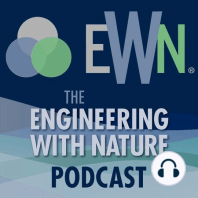24 min listen

Evolution of Nature Infrastructure Policy
Evolution of Nature Infrastructure Policy
ratings:
Length:
31 minutes
Released:
Oct 5, 2021
Format:
Podcast episode
Description
President Biden's January 2021 Executive Order, Tackling the Climate Crisis at Home and Abroad, emphasizes the urgency of taking action to build climate resiliency and specifically calls for the inclusion of nature-based solutions. Combined with the $1 trillion Infrastructure Investment and Jobs Act approved by the US Senate in August, 2021, which describes major infrastructure projects to be undertaken, these represent an unprecedented opportunity to incorporate Engineering With Nature approaches into infrastructure policy and projects. Our guests are Todd Bridges, Senior Research Scientist for Environmental Science with the U.S. Army Corps of Engineers and National Lead for EWN; Sarah Murdock, Director of US Climate Resilience and Water Policy at The Nature Conservancy; Justin Ehrenwerth, President and CEO of The Water Institute of the Gulf; and Mindy Simmons, Senior Policy Advisor, Aquatic Ecosystem Restoration Business Line Manager at the U.S. Army Corps of Engineers. The evolution of infrastructure policy can be seen, in part, through our experience with storms. As Todd notes, “following Hurricane Katrina, our collective focus was risk reduction. After Hurricane Sandy, the focus expanded to include resilience. Those events, separated by several years, intensified the dialogue, in a positive way, on engineering with nature and nature-based solutions.” Work done by The Nature Conservancy (TNC) in Cape May, New Jersey before Hurricane Sandy demonstrates the importance of natural infrastructure to storm risk reduction. Working with USACE, an ecosystem restoration project was undertaken that included holistic dune restoration, hydrologic improvements, and habitat restoration. According to Sarah, “before the project there was a history of flooding of the communities behind the preserve area. After Sandy, the dune restoration stood up and those communities only experienced negligible flooding.” The Water Institute of the Gulf (TWIG) was founded in response to Hurricanes Katrina and Rita. Justin describes the opportunity for incorporating natural and nature-based solutions “to create a blended approach that addresses the need for built infrastructure, married with natural infrastructure. For example, levees and flood walls blended with barrier islands and marsh to create a multiple lines of defense strategy that ultimately yields not only economic benefits through the protection of property and businesses and communities, but also social and environmental benefits.” Significant hurricane and storm events have clearly shaped policy at the federal level, but as Mindy notes, the Corps has been implementing engineering with nature solutions for over a century, describing the Yolo Bypass, designed by the Corps in the 1930s that helps divert flood water near Sacramento, California, while also providing valuable fish and wildlife habitat. From Mindy’s perspective, “hurricanes over the past century have brought a lot of attention to the Corps’ capabilities and Congress has provided direction through Water Resource Development Acts (WRDA) requiring the Corps to explicitly consider natural and nature-based solutions for flood risk management, hurricane and storm damage reduction and ecosystem restoration.” The benefits of employing natural and nature- based infrastructure is significant. Our guests believe that expanded value can be “unlocked” by including nature-based solutions, or natural infrastructure, as an integrated part of infrastructure investment. According to Sarah, “if we equate nature as a form of infrastructure, we can unlock the trillions of dollars that this world spends and invests in more traditional infrastructure and really think equally of nature as delivering a lot of the services that are essential.” Measuring those benefits is the focus of our discussion in Episode 2. As Todd says, “Our ability to describe, define substantiate the benefits and the costs related to nature is really the key to opening
Released:
Oct 5, 2021
Format:
Podcast episode
Titles in the series (83)
Characterizing Storm and Flood Risk Reduction Benefits Derived from Mangroves During Extreme Weather Events: As an undergraduate student at the University of Florida, Tori Tomiczek’s interests in geotechnical engineering and fluid mechanics, plus her curiosity about how structures were impacted by hurricanes, led to her to focus on coastal engineering.... by EWN - Engineering With Nature